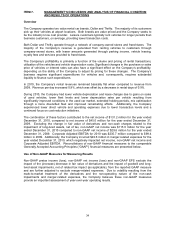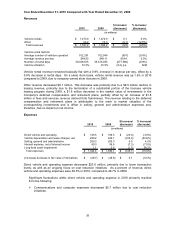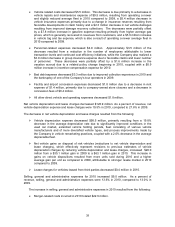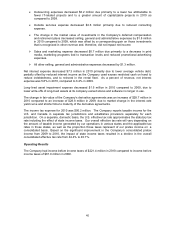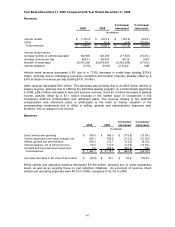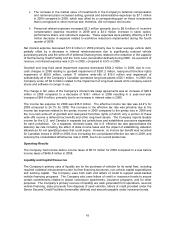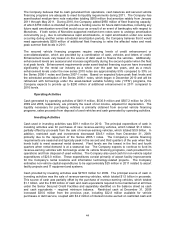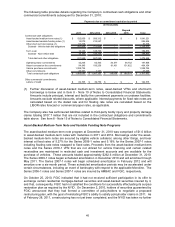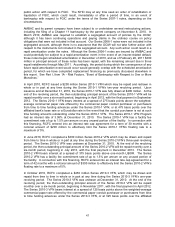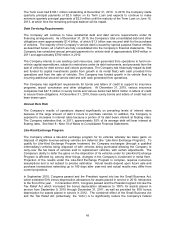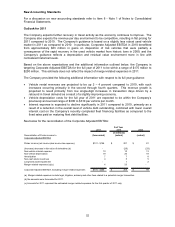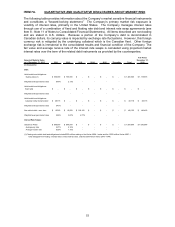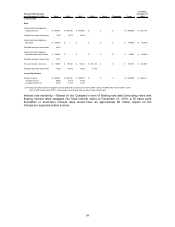Thrifty Car Rental 2010 Annual Report Download - page 45
Download and view the complete annual report
Please find page 45 of the 2010 Thrifty Car Rental annual report below. You can navigate through the pages in the report by either clicking on the pages listed below, or by using the keyword search tool below to find specific information within the annual report.The Company believes that its cash generated from operations, cash balances and secured vehicle
financing programs are adequate to meet its liquidity requirements during 2011. The Company has
asset-backed medium-term note maturities totaling $500 million that amortize ratably from January
2011 through May 2011. During 2010, the Company added $950 million of fleet financing capacity,
of which $750 million is intended to provide a funding source for future debt maturities, including any
future rapid amortization event that would occur as a result of an event of bankruptcy with respect to
Monolines. If both series of Monoline-supported medium-term notes were to undergo amortization
concurrently (e.g., due to simultaneous rapid amortizations, or rapid amortization under one series
occurring during another series scheduled amortization period), the Company believes that it would
need approximately $200 million of additional fleet financing to retire the affected notes and meet
peak summer fleet levels in 2011.
The secured vehicle financing programs require varying levels of credit enhancement or
overcollateralization, which are provided by a combination of cash, vehicles and letters of credit.
Enhancement levels vary based on the source of debt used to finance the vehicles. Additionally,
enhancement levels are seasonal and increase significantly during the second quarter when the fleet
is at peak levels. Enhancement requirements under asset-backed financing sources have increased
significantly for the rental car industry as a whole over the past two years, and as a result,
enhancement levels under the new series 2010 notes are approximately 55% compared to 30% on
the Series 2006-1 notes and Series 2007-1 notes. Based on expected future peak fleet levels and
the scheduled amortization of the Series 2006-1 notes, which began in December 2010 and will be
refinanced with borrowings under the asset-backed variable funding note (“VFN”) programs, the
Company expects to provide up to $200 million of additional enhancement in 2011 compared to
2010 levels.
Operating Activities
Cash generated by operating activities of $461.9 million, $535.9 million and $507.2 million for 2010,
2009 and 2008, respectively, are primarily the result of net income, adjusted for depreciation. The
liquidity necessary for purchasing vehicles is primarily obtained from secured vehicle financing
programs, sales proceeds from disposal of used vehicles and cash generated by operating activities.
Investing Activities
Cash used in investing activities was $59.1 million for 2010. The principal expenditure of cash in
investing activities was for purchases of new revenue-earning vehicles, which totaled $1.2 billion,
partially offset by proceeds from the sale of revenue-earning vehicles, which totaled $0.9 billion. In
addition, restricted cash and investments decreased $345.1 million from December 31, 2009,
primarily due to the repayment of the Series 2005-1 notes. The Company’s vehicle financing
requirements are seasonal and typically peak in the second and third quarters of the year when fleet
levels build to meet seasonal rental demand. Fleet levels are the lowest in the first and fourth
quarters when rental demand is at a seasonal low. The Company expects to continue to fund its
revenue-earning vehicles with borrowings under its vehicle financing programs, cash provided from
operations and from disposal of used vehicles. The Company also used cash for non-vehicle capital
expenditures of $23.0 million. These expenditures consist primarily of airport facility improvements
for the Company’s rental locations and information technology-related projects. The Company
estimates non-vehicle capital expenditures to be approximately $25 million in 2011 related to airport
facility projects and IT equipment and systems.
Cash provided by investing activities was $279.0 million for 2009. The principal source of cash in
investing activities was the sale of revenue-earning vehicles, which totaled $1.5 billion in proceeds.
This source of cash was partially offset by the purchase of revenue-earning vehicles, which totaled
$1.1 billion, and the $100 million of cash and cash equivalents required to be maintained at all times
under the Senior Secured Credit Facilities and separately identified on the balance sheet as cash
and cash equivalents – required minimum balance. Restricted cash at December 31, 2009
increased $26.0 million from the previous year, including $22.8 million available for vehicle
purchases or debt service, coupled with $3.2 million of interest income earned on restricted cash and
44


